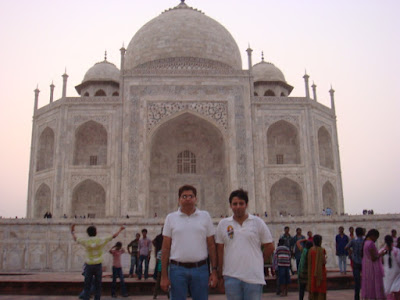Taj Mahal.
I had been visiting Delhi periodically for the last 15 years but never attempted to visit nearby Agra and Taj Mahal. Indifference towards monument? No. Languid disposition? Yes. Anyway, I had to make it along with my Japanese colleges coming from Tokyo.
The traffic in Delhi until we reached Delhi-Agra highway, was anything but chaotic, however the drive on highway was very comfortable. But, then, the way to Taj in Agra, the city that housed symbol of love, is through unhygienic surroundings and dirty roads - over flowing open drains or stench of left overs of human uncivility.
In contrast, no sooner we crossed the huge red gate, Taj Mahal stood majestically. This white shining edifice is breathtakingly beautiful. With its four-ornamental and guardian pillars, Taj Mahal is truly a gem in India’s diadem. Now I regret my earlier indolence of delaying the visit. It is made of special white marble of high quality; some of it was brought from Persia.
Shah Jahan, the grandson of Akbar built Taj in memory of his loving and departed wife, Mumtaj Mahal. Mumtaj was his third wife and died while delivering his 14th child. The grieving Shah Jahan built the mausoleum as an expression of his love that houses tombs of Mumtaj and his, later. So much adoration for a woman and love! Great! Deffinitely, he had strained relations with all future widowers and husbands.
The construction of Taj started in the year 1642 and took 20 years to complete with skilled artisans from India and other parts of Asia. Around 1000 elephants toiled during 2-decade long construction; aiding human imagination, it is said.
The pathways to Taj from main gate are through well-maintained gardens.
When once I stood next to Taj, I realized its huge size, but hardly interesting, may be, because the symbol of love is out of single frame of sight. The fine and intricate artwork on marble is a commentary on the skill of artisans.
One rumour has been running thru the history of Taj that Shah Jahan had killed or chopped off hands of artisans who built Taj, preventing them to replicate it. Thus, he desired his creation to be unique and single. A man who built embodiment of Love, could he be so ruthless? I doubt.
In its close to 400 years of existence, Taj weathered ravages of time, onslaught of rebels and wrath of a brutally insensitive British governor whose vain attempts to auction off Taj, not once, but twice, left the monument intact.
British humourist and writer Edward Lear once described, after visiting Taj, "Henceforth, let the inhabitants of the world be divided into two classes - them as has seen the Taj Mahal, and them as hasn't."
Though there are other equally great monuments in Agra, I left the city next day morning, back to Bangalore – contended, for the time being, to be on the Taj side of the world.
------
------













